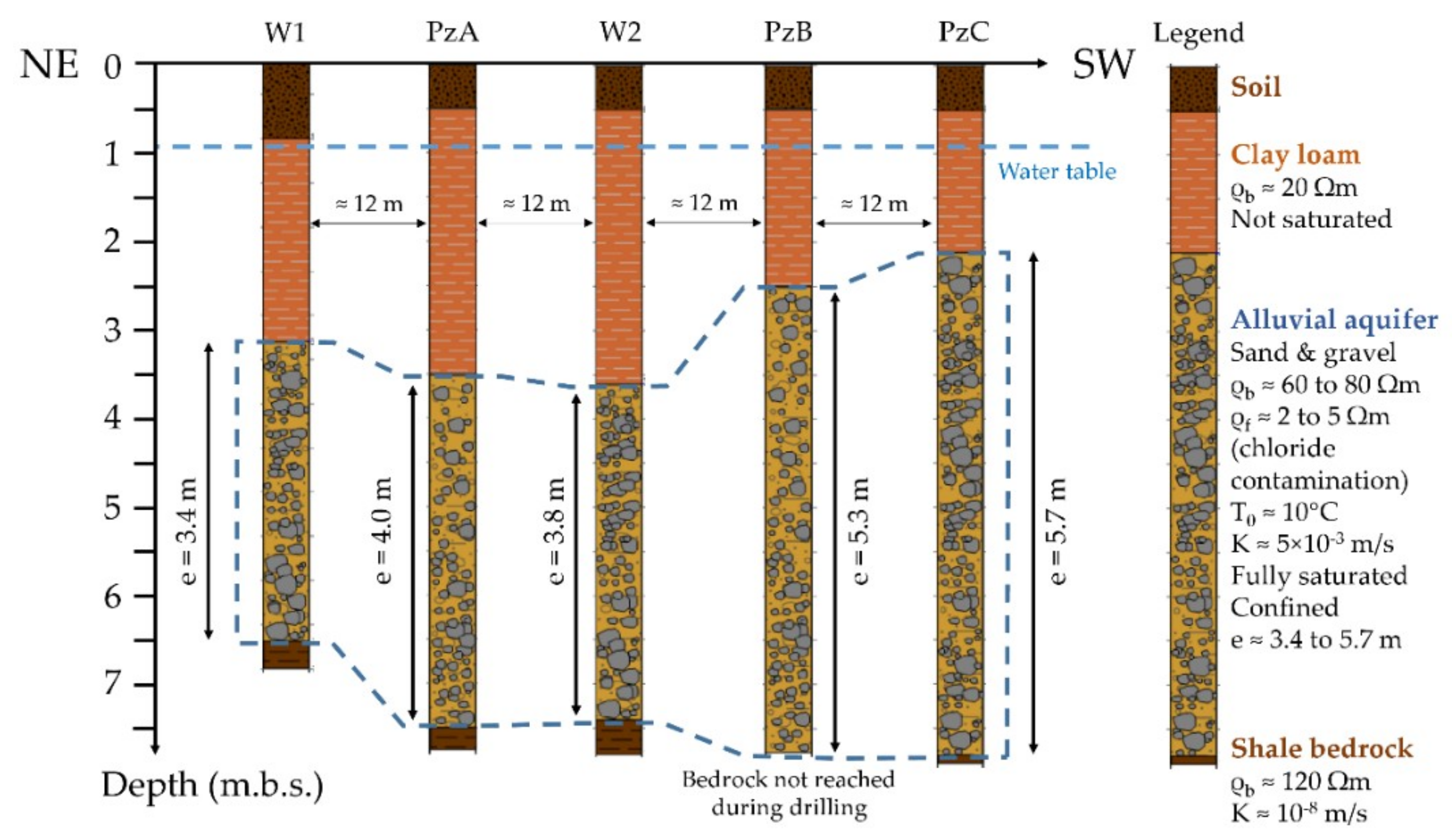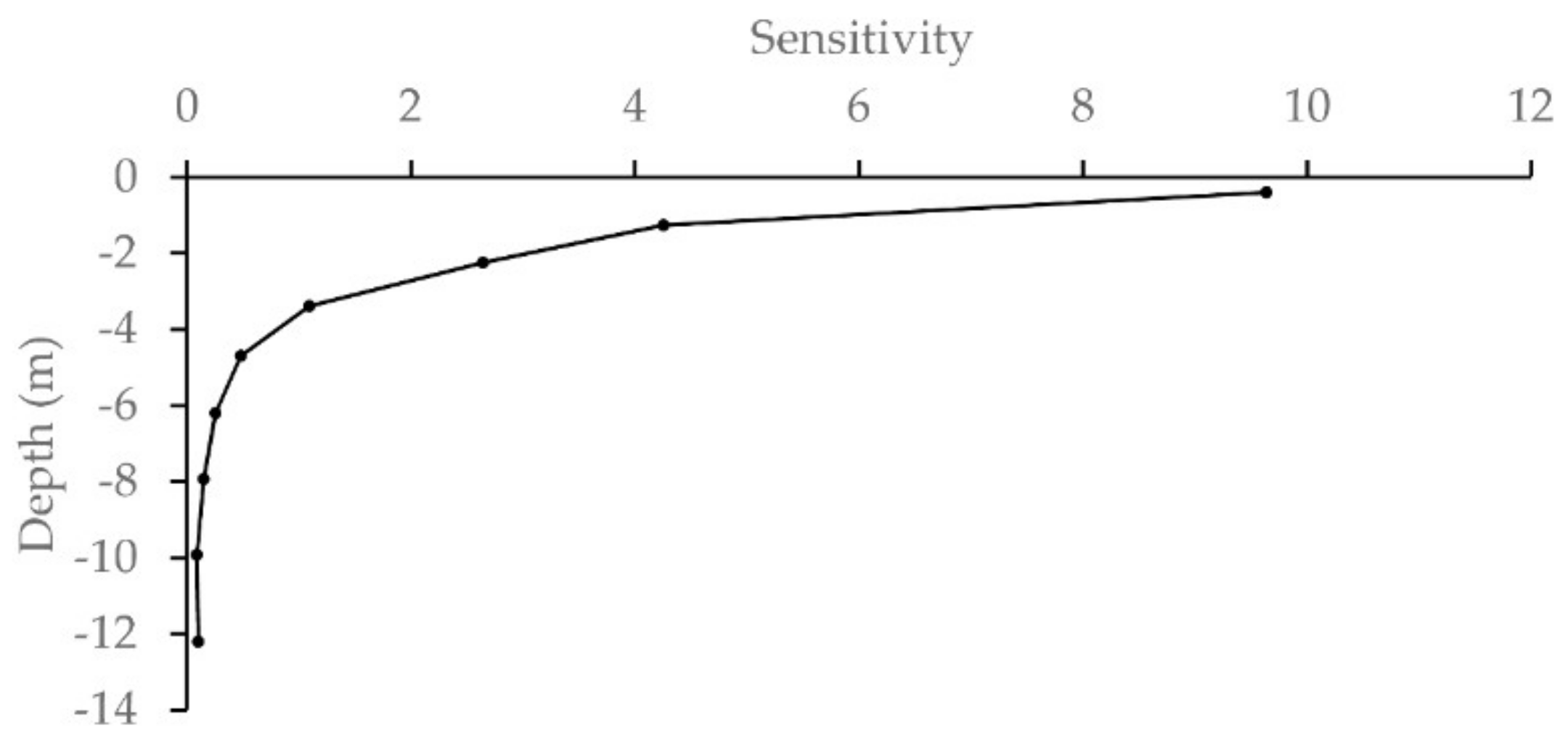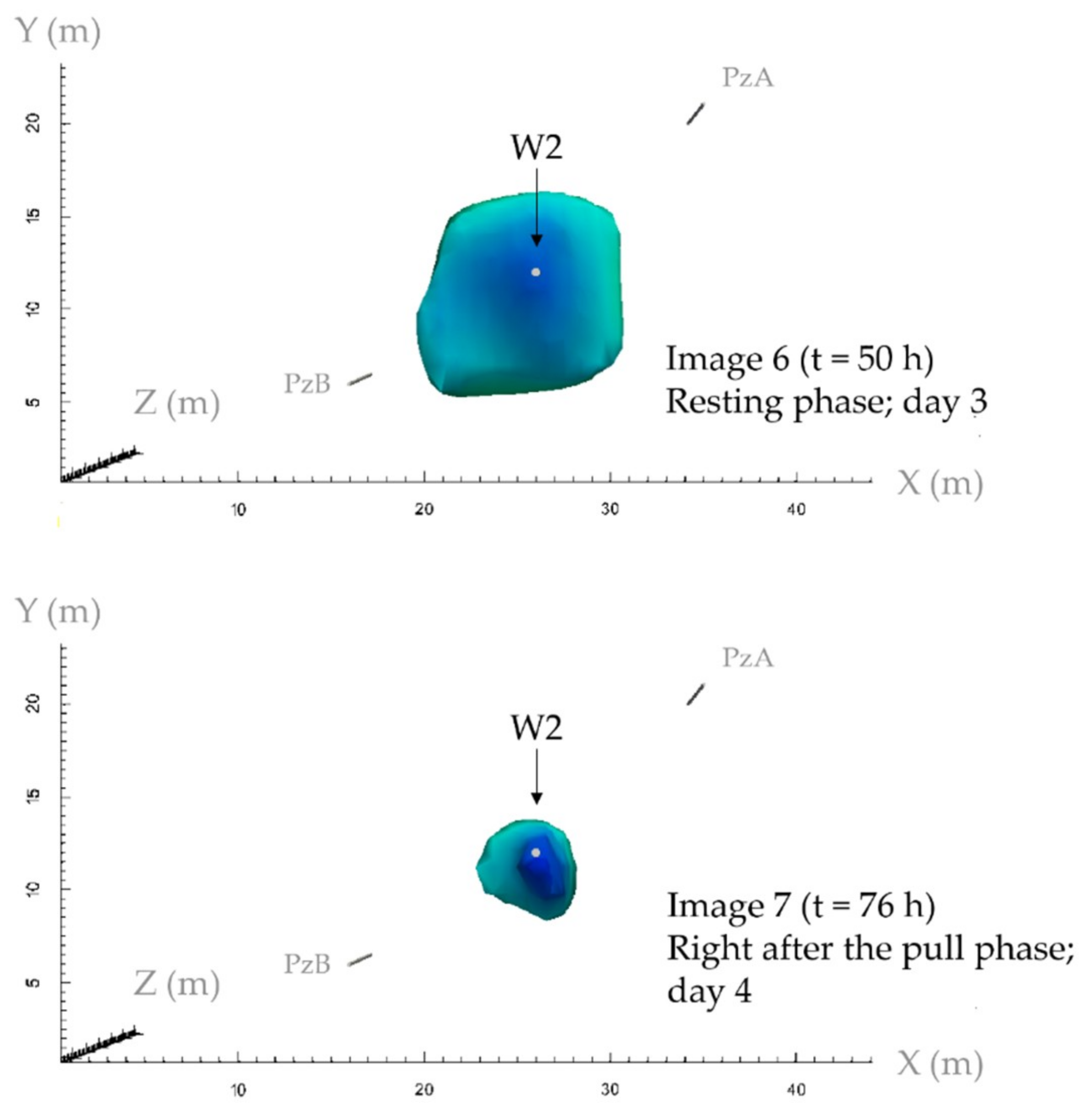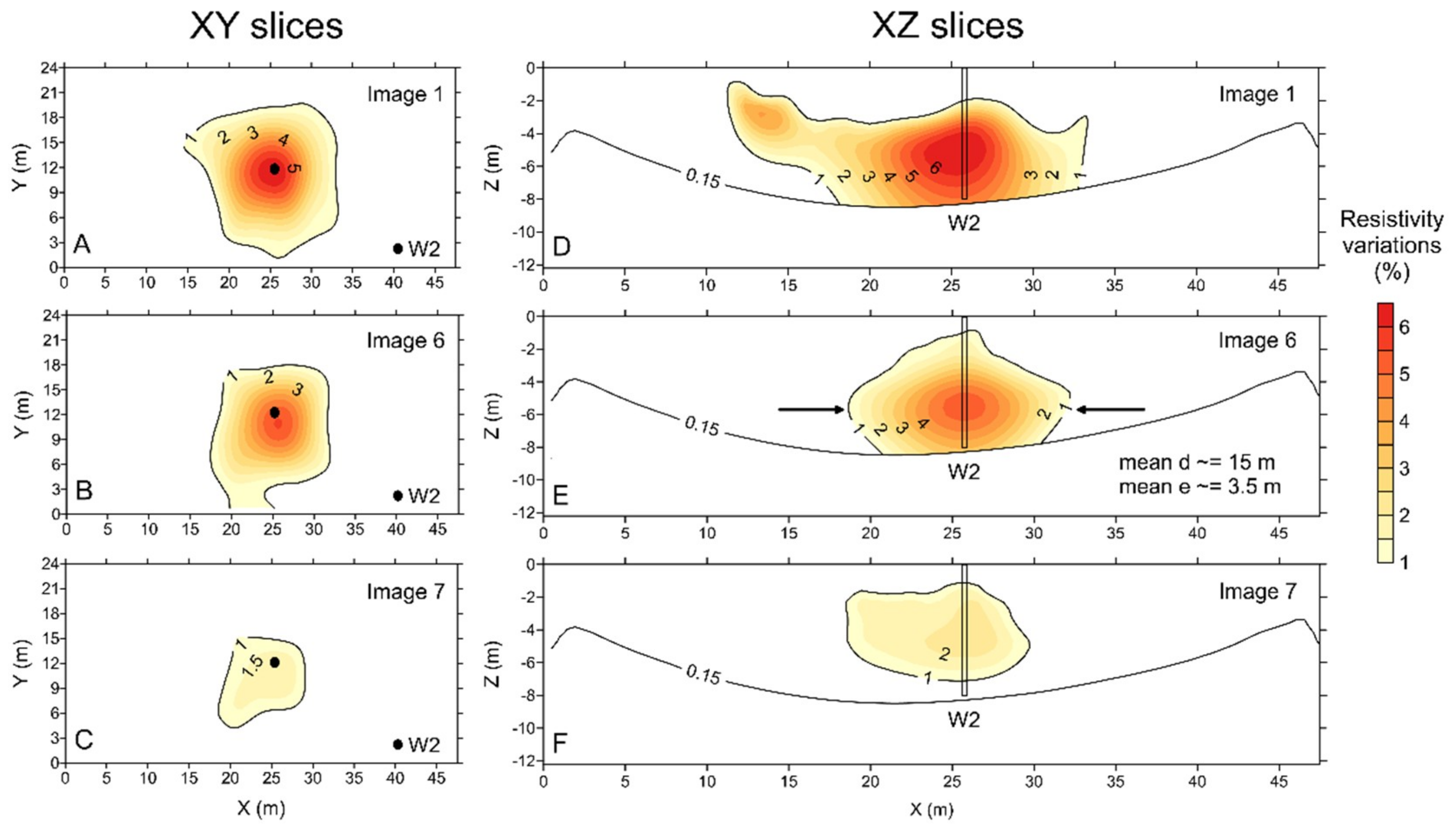Heat as a Proxy to Image Dynamic Processes with 4D Electrical Resistivity Tomography
Abstract
:1. Introduction
2. Materials and Methods
2.1. Experimental Site
2.2. The Push/Pull Test
- Groundwater is pumped out of W1 at a flow rate of 2.55 m3/h (T0 = 10 °C) using a surface pump;
- Water is heated (ΔT = 30 K) using a mobile water flow heater (Swingtec AquaMobil DH7);
- Heated water (T = 40 °C) is injected in W2 with the same flow rate of 2.55 m3/h and for 5.33 h (13.6 m3 in total) at an injection depth of about 6 m;
- Resting phase of 72 h during which full 3D ERT images are collected;
- Groundwater is pumped back out of W2 during 4.5 h at a mean flow rate of 7.6 m3/h (34.2 m3 in total).
2.3. 3D Electrical Resistivity Monitoring
2.3.1. Electrodes Configuration
2.3.2. Data Error and Time-Lapse Data Analysis
2.3.3. Data Inversion
2.3.4. Post-Processing
3. Results and Discussion
4. Conclusions and Perspective
Author Contributions
Funding
Acknowledgments
Conflicts of Interest
References
- Auken, E.; Boesen, T.; Christiansen, A.V. Chapter Two—A Review of Airborne Electromagnetic Methods with Focus on Geotechnical and Hydrological Applications From 2007 to 2017. In Advances in Geophysics; Nielsen, L., Ed.; Elsevier: London, UK, 2017; Volume 58, pp. 47–93. ISBN 0065-2687. [Google Scholar]
- Binley, A.; Hubbard, S.S.; Huisman, J.A.; Revil, A.; Robinson, D.A.; Singha, K.; Slater, L.D. The emergence of hydrogeophysics for improved understanding of subsurface processes over multiple scales: The Emergence of Hydrogeophysics. Water Resour. Res. 2015, 51, 3837–3866. [Google Scholar] [CrossRef] [PubMed]
- Singha, K.; Day-Lewis, F.D.; Johnson, T.; Slater, L.D. Advances in interpretation of subsurface processes with time-lapse electrical imaging. Hydrol. Process. 2015, 29, 1549–1576. [Google Scholar] [CrossRef]
- Wilkinson, P.B.; Uhlemann, S.; Meldrum, P.I.; Chambers, J.E.; Carrière, S.; Oxby, L.S.; Loke, M.H. Adaptive time-lapse optimized survey design for electrical resistivity tomography monitoring. Geophys. J. Int. 2015, 203, 755–766. [Google Scholar] [CrossRef] [Green Version]
- Nguyen, F.; Kemna, A.; Antonsson, A.; Engesgaard, P.; Kuras, O.; Ogilvy, R.; Gisbert, J.; Jorreto, S.; Pulido-Bosch, A. Characterization of seawater intrusion using 2D electrical imaging. Near Surf. Geophys. 2009, 7, 377–390. [Google Scholar] [CrossRef] [Green Version]
- Chambers, J.E.; Gunn, D.A.; Wilkinson, P.B.; Meldrum, P.I.; Haslam, E.; Holyoake, S.; Kirkham, M.; Kuras, O.; Merritt, A.; Wragg, J. 4D electrical resistivity tomography monitoring of soil moisture dynamics in an operational railway embankment. Near Surf. Geophys. 2014, 12, 61–72. [Google Scholar] [CrossRef]
- Watlet, A.; Kaufmann, O.; Triantafyllou, A.; Poulain, A.; Chambers, J.E.; Meldrum, P.I.; Wilkinson, P.B.; Hallet, V.; Quinif, Y.; Van Ruymbeke, M.; et al. Imaging groundwater infiltration dynamics in the karst vadose zone with long-term ERT monitoring. Hydrol. Earth Syst. Sci. 2018, 22, 1563–1592. [Google Scholar] [CrossRef] [Green Version]
- Robert, T.; Caterina, D.; Deceuster, J.; Kaufmann, O.; Nguyen, F. A salt tracer test monitored with surface ERT to detect preferential flow and transport paths in fractured/karstified limestones. Geophysics 2012, 77, B55–B67. [Google Scholar] [CrossRef]
- Perri, M.; Cassiani, G.; Gervasio, I.; Deiana, R.; Binley, A. A saline tracer test monitored via both surface and cross-borehole electrical resistivity tomography: Comparison of time-lapse results. J. Appl. Geophys. 2012, 79, 6–16. [Google Scholar] [CrossRef]
- Auken, E.; Doetsch, J.; Fiandaca, G.; Christiansen, A.V.; Gazoty, A.; Cahill, A.G.; Jakobsen, R. Imaging subsurface migration of dissolved CO2 in a shallow aquifer using 3-D time-lapse electrical resistivity tomography. J. Appl. Geophys. 2014, 101, 31–41. [Google Scholar] [CrossRef]
- Dumont, G.; Robert, T.; Nguyen, F. Electrical resistivity tomography and distributed temperature sensing monitoring to assess the efficiency of horizontal recirculation drains on retrofit bioreactor landfills. Geophysics 2018, 83, B13–B23. [Google Scholar] [CrossRef]
- Caterina, D.; Flores Orozco, A.; Nguyen, F. Long-term ERT monitoring of biogeochemical changes of an aged hydrocarbon contamination. J. Contam. Hydrol. 2017, 201, 19–29. [Google Scholar] [CrossRef] [PubMed]
- Masy, T.; Caterina, D.; Tromme, O.; Lavigne, B.; Thonart, P.; Hiligsmann, S.; Nguyen, F. Electrical resistivity tomography to monitor enhanced biodegradation of hydrocarbons with Rhodococcus erythropolis T902.1 at a pilot scale. J. Contam. Hydrol. 2016, 184, 1–13. [Google Scholar] [CrossRef] [PubMed]
- Doetsch, J.; Linde, N.; Vogt, T.; Binley, A.; Green, A.G. Imaging and quantifying salt-tracer transport in a riparian groundwater system by means of 3D ERT monitoring. Geophysics 2012, 77, B207–B218. [Google Scholar] [CrossRef] [Green Version]
- Müller, K.; Vanderborght, J.; Englert, A.; Kemna, A.; Huisman, J.A.; Rings, J.; Vereecken, H. Imaging and characterization of solute transport during two tracer tests in a shallow aquifer using electrical resistivity tomography and multilevel groundwater samplers. Water Resour. Res. 2010, 46. [Google Scholar] [CrossRef] [Green Version]
- Supper, R.; Ottowitz, D.; Jochum, B.; Römer, A.; Pfeiler, S.; Gruber, S.; Keuschnig, M.; Ita, A. Geoelectrical monitoring of frozen ground and permafrost in alpine areas: Field studies and considerations towards an improved measuring technology. Near Surf. Geophys. 2014, 12, 93–115. [Google Scholar] [CrossRef]
- Hermans, T.; Vandenbohede, A.; Lebbe, L.; Nguyen, F. A shallow geothermal experiment in a sandy aquifer monitored using electric resistivity tomography. Geophysics 2012, 77, B11–B21. [Google Scholar] [CrossRef] [Green Version]
- Hayley, K.; Bentley, L.R.; Gharibi, M.; Nightingale, M. Low temperature dependence of electrical resistivity: Implications for near surface geophysical monitoring. Geophys. Res. Lett. 2007, 34. [Google Scholar] [CrossRef]
- Hayley, K.; Bentley, L.R.; Pidlisecky, A. Compensating for temperature variations in time-lapse electrical resistivity difference imaging. Geophysics 2010, 75, WA51–WA59. [Google Scholar] [CrossRef]
- Hermans, T.; Nguyen, F.; Robert, T.; Revil, A. Geophysical Methods for Monitoring Temperature Changes in Shallow Low Enthalpy Geothermal Systems. Energies 2014, 7, 5083–5118. [Google Scholar] [CrossRef] [Green Version]
- Ramirez, A.; Daily, W.; LaBrecque, D.J.; Owen, E.; Chesnut, D. Monitoring an underground steam injection process using electrical resistance tomography. Water Resour. Res. 1993, 29, 73–87. [Google Scholar] [CrossRef]
- Hermans, T.; Daoudi, M.; Vandenbohede, A.; Robert, T.; Caterina, D.; Nguyen, F. Comparison of temperature estimates from heat transport model and electrical resistivity tomography during a shallow heat injection and storage experiment. Ber. Geol. Bundesanst. 2012, 93, 43–48. [Google Scholar]
- Hermans, T.; Wildemeersch, S.; Jamin, P.; Orban, P.; Brouyère, S.; Dassargues, A.; Nguyen, F. Quantitative temperature monitoring of a heat tracing experiment using cross-borehole ERT. Geothermics 2015, 53, 14–26. [Google Scholar] [CrossRef] [Green Version]
- Wildemeersch, S.; Jamin, P.; Orban, P.; Hermans, T.; Klepikova, M.; Nguyen, F.; Brouyère, S.; Dassargues, A. Coupling heat and chemical tracer experiments for estimating heat transfer parameters in shallow alluvial aquifers. J. Contam. Hydrol. 2014, 169, 90–99. [Google Scholar] [CrossRef]
- Robert, T.; Hermans, T.; Dumont, G.; Nguyen, F.; Rwabuhungu, D.E. Reliability of ERT-derived Temperature-Insights from Laboratory Measurements. In Proceedings of the Near Surface Geoscience 2013-19th EAGE European Meeting of Environmental and Engineering Geophysics, Bochum, Germany, 9–11 September 2013. [Google Scholar]
- Giordano, N.; Comina, C.; Mandrone, G. Laboratory scale geophysical measurements aimed at monitoring the thermal affected zone in Underground Thermal Energy Storage (UTES) applications. Geothermics 2016, 61, 121–134. [Google Scholar] [CrossRef]
- Arato, A.; Boaga, J.; Comina, C.; De Seta, M.; Di Sipio, E.; Galgaro, A.; Giordano, N.; Mandrone, G. Geophysical monitoring for shallow geothermal applications - Two Italian case histories. First Break 2015, 33, 75–79. [Google Scholar]
- Lesparre, N.; Robert, T.; Nguyen, F.; Boyle, A.; Hermans, T. 4D electrical resistivity tomography (ERT) for aquifer thermal energy storage monitoring. Geothermics 2019, 77, 368–382. [Google Scholar] [CrossRef]
- Giordano, N.; Arato, A.; Comina, C.; Mandrone, G. Time-lapse electrical resistivity imaging of the thermally affected zone of a Borehole Thermal Energy Storage system near Torino (Northern Italy). J. Appl. Geophys. 2017, 140, 123–134. [Google Scholar] [CrossRef]
- Cultrera, M.; Boaga, J.; Di Sipio, E.; Dalla Santa, G.; De Seta, M.; Galgaro, A. Modelling an induced thermal plume with data from electrical resistivity tomography and distributed temperature sensing: A case study in northeast Italy. Hydrogeol. J. 2018, 26, 837–851. [Google Scholar] [CrossRef]
- Comina, C.; Giordano, N.; Ghidone, G.; Fischanger, F. Time-Lapse 3D Electric Tomography for Short-time Monitoring of an Experimental Heat Storage System. Geosciences 2019, 9, 167. [Google Scholar] [CrossRef]
- De Schepper, G.; Paulus, C.; Bolly, P.Y.; Hermans, T.; Lesparre, N.; Robert, T. Assessment of short-term aquifer thermal energy storage for demand-side management perspectives: Experimental and numerical developments. Appl. Energy 2019, 242, 534–546. [Google Scholar] [CrossRef] [Green Version]
- Vandenbohede, A.; Hermans, T.; Nguyen, F.; Lebbe, L. Shallow heat injection and storage experiment: Heat transport simulation and sensitivity analysis. J. Hydrol. 2011, 409, 262–272. [Google Scholar] [CrossRef]
- Hermans, T.; Lesparre, N.; De Schepper, G.; Robert, T. Bayesian evidential learning: a field validation using push-pull tests. Hydrogeol. J. 2019, 27, 1661–1672. [Google Scholar] [CrossRef] [Green Version]
- Hermans, T.; Nguyen, F.; Klepikova, M.; Dassargues, A.; Caers, J. Uncertainty quantification of medium-term heat storage from short-term geophysical experiments using Bayesian Evidential Learning. Water Resour. Res. 2018, 54, 2931–2948. [Google Scholar] [CrossRef]
- Hermans, T.; Nguyen, F.; De Schepper, G.; Lesparre, N.; Robert, T. 10 years of temperature monitoring experiments using electrical resistivity tomography: What have we learned? In Proceedings of the 1st Conference on Geophysics for Geothermal-Energy Utilization and Renewable-Energy Storage, The Hague, The Netherlands, 8–12 September 2019; pp. 1–4. [Google Scholar]
- Robert, T.; Hermans, T.; Lesparre, N.; De Schepper, G.; Nguyen, F.; Defourny, A.; Jamin, P.; Orban, P.; Brouyère, S.; Dassargues, A. Towards a subsurface predictive-model environment to simulate aquifer thermal energy storage for demand-side management applications. In Proceedings of the 10th International Conference on System Simulation in Buildings, Liège, Belgium, 10–12 December 2018; p. 017. [Google Scholar]
- Van Hoorde, M.; Hermans, T.; Dumont, G.; Nguyen, F. 3D electrical resistivity tomography of karstified formations using cross-line measurements. Eng. Geol. 2017, 220, 123–132. [Google Scholar] [CrossRef]
- Cho, I.K.; Yeom, J.Y. Crossline resistivity tomography for the delineation of anomalous seepage pathways in an embankment dam. Geophysics 2007, 72, G31–G38. [Google Scholar] [CrossRef]
- LaBrecque, D.J.; Miletto, M.; Daily, W.; Ramirez, A.; Owen, E. The effects of noise on Occam’s inversion of resistivity tomography data. Geophysics 1996, 61, 538–548. [Google Scholar] [CrossRef]
- Slater, L.; Binley, A.M.; Daily, W.; Johnson, R. Cross-hole electrical imaging of a controlled saline tracer injection. J. Appl. Geophys. 2000, 44, 85–102. [Google Scholar] [CrossRef]
- Koestel, J.; Kemna, A.; Javaux, M.; Binley, A.; Vereecken, H. Quantitative imaging of solute transport in an unsaturated and undisturbed soil monolith with 3-D ERT and TDR. Water Resour. Res. 2008, 44, W12411. [Google Scholar] [CrossRef]
- Lesparre, N.; Nguyen, F.; Kemna, A.; Robert, T.; Hermans, T.; Daoudi, M.; Flores-Orozco, A. A new approach for time-lapse data weighting in electrical resistivity tomography. Geophysics 2017, 82, E325–E333. [Google Scholar] [CrossRef]
- Oldenburg, D.W.; Li, Y. Subspace linear inverse method. Inverse Probl. 1994, 10, 915–935. [Google Scholar] [CrossRef]
- de Groot-Hedlin, C.D.; Constable, S.C. Occam’s inversion to generate smooth, two-dimensional models from magnetotelluric data. Geophysics 1990, 55, 1613–1624. [Google Scholar] [CrossRef]
- Loke, M.H.; Acworth, I.; Dahlin, T. A comparison of smooth and blocky inversion methods in 2D electrical imaging surveys. Explor. Geophys. 2003, 34, 182–187. [Google Scholar] [CrossRef]
- Hilbich, C.; Marescot, L.; Hauck, C.; Loke, M.; Mäusbacher, R. Applicability of electrical resistivity tomography monitoring to coarse blocky and ice-rich permafrost landforms. Permafr. Periglac. Process. 2009, 20, 269–284. [Google Scholar] [CrossRef] [Green Version]
- Blaschek, R.; Hördt, A.; Kemna, A. A new sensitivity-controlled focusing regularization scheme for the inversion of induced polarization data based on the minimum gradient support. Geophysics 2008, 73, F45–F54. [Google Scholar] [CrossRef]
- Nguyen, F.; Kemna, A.; Robert, T.; Hermans, T. Data-driven selection of the minimum-gradient support parameter in time-lapse focused electric imaging. Geophysics 2016, 81, A1–A5. [Google Scholar] [CrossRef]
- Miller, C.R.; Routh, P.S.; Brosten, T.R.; McNamara, J.P. Application of time-lapse ERT imaging to watershed characterization. Geophysics 2008, 73, G7–G17. [Google Scholar] [CrossRef] [Green Version]
- Caterina, D.; Beaujean, J.; Robert, T.; Nguyen, F. A comparison study of different image appraisal tools for electrical resistivity tomography. Near Surf. Geophys. 2013, 11, 639–657. [Google Scholar] [CrossRef]
- Chrétien, M.; Lataste, J.F.; Fabre, R.; Denis, A. Electrical resistivity tomography to understand clay behavior during seasonal water content variations. Eng. Geol. 2014, 169, 112–123. [Google Scholar] [CrossRef]












| Acquisition Device | ABEM Terrameter LS | ||
| Number of Acquisition Channels | 8 | ||
| Contact Resistance | maximum 50 ± 25 Ω | ||
| Current Intensity | from 20 to 500 mA | ||
| Stacking | 2–3 repetitions with a quality factor of 1% | ||
| Repetition Error | mean 0.20%, std. 0.60% | ||
| Delay Time | 0.2 s | ||
| Acquisition Time | 0.3 s | ||
| Total injection Time | 0.5 s | ||
| Unit Electrode Spacing in X | 2 m | ||
| Unit Electrode Spacing in Y | 3 m | ||
| Number of Electrodes Per Profile (in X) | 21 | ||
| Number of Profiles (in Y) | 9 | ||
| Total Number of Electrodes | 189 | ||
| Dimension of the Full Set-up (X × Y) | 48 m × 24 m | ||
| Reciprocal Measurements | For selected sequences only | ||
| Reciprocal Error | <2% | ||
| Depth of Investigation | ~8 m | ||
| Electrodes Arrays | Inline dipole-dipole | Cross-line dipole-dipole | Inline gradient |
| Number of Quadrupoles Per Group | 654 | 480 | 372 |
| Acquisition Time Per Group | 15 min | 10 min | 8 min |
| Total Number of Quadrupoles Per Image | 4518 (full) and 1506 (light) | ||
| Acquisition Time for a Full Image | 2 h | ||
| Acquisition Time for a Light Image | 35 min | ||
| Inversion Parameters | Robust data constraint (L1 norm) Standard “smoothness” model constraint (L2 norm) | ||
| Stopping Criterion | Iteration 3 with a final absolute error ~2% | ||
| Time-lapse Scheme | Independent inversions | ||
| Time-lapse Reference | 2nd background image for each time step | ||
| Phase | Elapsed Time [h] 1 | Date (May [dd] 2015) and Time |
|---|---|---|
| Implementation | - | 04 (11:00 AM) |
| 1st background ERT image | - | 04 (04:00 PM) |
| Storm and heavy rain | - | at night |
| 2nd background ERT image | - | 05 (08:30 AM) |
| Push start | 0 | 05 (11:00 AM) |
| Light 3D ERT image a | 3 | 05 (02:00 PM) |
| Light 3D ERT image b | 4 | 05 (03:00 PM) |
| Light 3D ERT image c | 5 | 05 (04:00 PM) |
| Push end | 5.33 | 05 (04:20 PM) |
| Full 3D ERT image 1 | 6 | 05 (05:00 PM) |
| Heavy rain | - | 06 (AM & PM) |
| Full 3D ERT image 2 | 23 | 06 (10:00 AM) |
| Full 3D ERT image 3 | 25 | 06 (12:00 AM) |
| Full 3D ERT image 4 | 27 | 06 (02:00 PM) |
| Light 3D ERT image d | 29 | 06 (04:00 PM) |
| Full 3D ERT image 5 | 47 | 07 (10:00 AM) |
| Pump test | 48.5 | 07 (11:30 AM) |
| Full 3D ERT image 6 | 50 | 07 (01:00 PM) |
| Light 3D ERT image e | 70 | 08 (09:00 PM) |
| Pull start | 71.15 | 08 (10:10 AM) |
| Light 3D ERT image f | 71.5 | 08 (10:30 AM) |
| Light 3D ERT image g | 72.15 | 08 (11:10 AM) |
| Light 3D ERT image h | 72.8 | 08 (11:50 AM) |
| Light 3D ERT image i | 73.45 | 08 (12:30 AM) |
| Light 3D ERT image j | 74.1 | 08 (01:10 PM) |
| Light 3D ERT image k | 74.75 | 08 (01:50 PM) |
| Pull end | 75.5 | 08 (02:30 PM) |
| Full 3D ERT image 7 | 76 | 08 (02:30 PM) |
© 2019 by the authors. Licensee MDPI, Basel, Switzerland. This article is an open access article distributed under the terms and conditions of the Creative Commons Attribution (CC BY) license (http://creativecommons.org/licenses/by/4.0/).
Share and Cite
Robert, T.; Paulus, C.; Bolly, P.-Y.; Koo Seen Lin, E.; Hermans, T. Heat as a Proxy to Image Dynamic Processes with 4D Electrical Resistivity Tomography. Geosciences 2019, 9, 414. https://doi.org/10.3390/geosciences9100414
Robert T, Paulus C, Bolly P-Y, Koo Seen Lin E, Hermans T. Heat as a Proxy to Image Dynamic Processes with 4D Electrical Resistivity Tomography. Geosciences. 2019; 9(10):414. https://doi.org/10.3390/geosciences9100414
Chicago/Turabian StyleRobert, Tanguy, Claire Paulus, Pierre-Yves Bolly, Emma Koo Seen Lin, and Thomas Hermans. 2019. "Heat as a Proxy to Image Dynamic Processes with 4D Electrical Resistivity Tomography" Geosciences 9, no. 10: 414. https://doi.org/10.3390/geosciences9100414
APA StyleRobert, T., Paulus, C., Bolly, P.-Y., Koo Seen Lin, E., & Hermans, T. (2019). Heat as a Proxy to Image Dynamic Processes with 4D Electrical Resistivity Tomography. Geosciences, 9(10), 414. https://doi.org/10.3390/geosciences9100414






